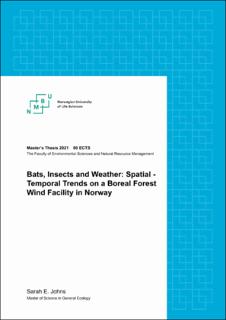| dc.contributor.advisor | Eldegard, Katrine | |
| dc.contributor.advisor | McKay, April Riderbo | |
| dc.contributor.advisor | Birkemoe, Tone | |
| dc.contributor.advisor | Steen, Ronny | |
| dc.contributor.author | Johns, Sarah Elizabeth | |
| dc.coverage.spatial | Norway | en_US |
| dc.date.accessioned | 2021-10-15T11:59:46Z | |
| dc.date.available | 2021-10-15T11:59:46Z | |
| dc.date.issued | 2021 | |
| dc.identifier.uri | https://hdl.handle.net/11250/2823341 | |
| dc.description.abstract | Bats and insects are valuable indicators of ecosystem health. As both organisms are potential bioindicators, it is important to understand how they interact with each other and their environment. Bats and insects are facing numerous threats to their habitat and resources; one being wind energy development. I monitored patterns in bat and insect activity on a wind facility located in boreal forest in Norway during summer and early autumn of 2020. Turbine pads and potential bat and insect ‘control’ habitats were sampled. Bat activity was monitored using acoustic detectors set to record calls from one hour before sunset and until one hour after sunrise. Insect activity was monitored using camera traps. Weather was monitored using data loggers erected in the field and wind turbine data. The aim of this study was to increase our understanding of bat species community composition on a wind facility in a boreal forest and monitor the spatio-temporal relationship between bat activity, insect abundance and weather (temperature and wind speed). My main questions were where does spatial variation in bat activity occur across habitats (control/turbine sites/at height), what temporal patterns in bat activity are detected, does weather have a significant effect on this activity, and is insect abundance related to bat activity on the wind facility? Long range echolocators, which includes Northern bats (Eptesicus nilssonii), were the most prevalent bat guild across the facility. Spatially, average bat activity across the season did not differ between turbine pads and control habitats. Temporally, bat activity was highest later in the summer (late July and early August) at the turbine pads and earlier in summer (July) at control habitats. Temperature had a significant positive effect on bat activity and insect abundance while wind speed had a negative effect on insect abundance and bat activity. Bat activity was positively related to insect abundance, but my results suggest temperature influences bat activity more strongly than does insect abundance on the Marker Vindpark. My findings may have implications for unknown or detrimental impacts on unknown bat populations in boreal forests due to land use and climate change and the increasing development of wind turbines in Scandinavia. The methods development component (simultaneous non-invasive sampling of bats and insects) of the study contributes to Norway’s and the global effort of creating consistent, long term and broad scale monitoring necessary for understanding and mitigating defaunation. | en_US |
| dc.description.sponsorship | Norwegian Environmental Agency (Miljødirektoratet) | en_US |
| dc.language.iso | eng | en_US |
| dc.publisher | Norwegian University of Life Sciences, Ås | en_US |
| dc.rights | Attribution-NonCommercial-NoDerivatives 4.0 Internasjonal | * |
| dc.rights.uri | http://creativecommons.org/licenses/by-nc-nd/4.0/deed.no | * |
| dc.subject | Bats | en_US |
| dc.subject | Eptesicus nilssonii | en_US |
| dc.subject | Insects | en_US |
| dc.subject | Wind energy | en_US |
| dc.subject | Boreal forests | en_US |
| dc.subject | Echolocators | en_US |
| dc.title | Bats, insects and weather : spatial-temporal trends on a boreal forest wind facility in Norway | en_US |
| dc.type | Master thesis | en_US |
| dc.subject.nsi | VDP::Mathematics and natural science: 400 | en_US |
| dc.description.localcode | M-ECOL | en_US |

